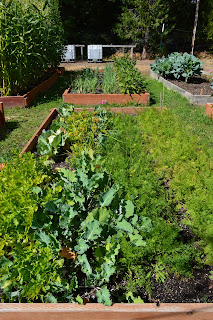Garden Maintenance
With summer in full swing and your garden in full bloom, now’s the time to maintain and enjoy the fruits of your labors. Maintaining your garden is simple: water, weed, mulch, feed, stake, and deadhead.
1. Water – only when needed
- Newly planted plants need more water than established plants
- Hand water – hold the water close to the soil - saturate the roots.
- Watering bags – use on trees to slowly release water into the soil
- Water deeply – use sprinklers for an hour or two during dry periods.
- Run sprinklers during the early morning, late evening or at night to avoid evaporation.
- Water established plants only when needed (showing signs of wilting)
2. Weed Control
Hand weeding – use hand tools to remove unwanted plants
- Tools: garden spade, dandelion fork, hand trowel, hand hoe, hori-hori (Japanese farmer’s knife)
- Remember to wear gloves
- Compost weeds (expect those with fully ripened seeds so they don’t reestablish in your garden)
String Trimmers – be careful not to damage tree bark
Mechanical removal – use a shovel to remove woody plants
Cut down – remove woody plants with pruning equipment
- Cut the stump close to the ground – remove suckers as they appear
Herbicide – not recommended but sometimes necessary
3. Mulch
- Reduces water evaporation, which reduces the need to water excessively.
- Reduces weeds
- Enriches the soil as it naturally breaks down
Tips:
- Mulch to a depth of 2-3 inches
- Do not apply to close to the plant’s base (or crown)
- Use pea gravel to mulch plants that need drainage and air flow (rock garden & Mediterranean plants)
NOTE: Leave some bare earth for ground-dwelling bees that nest in the soil.
4. Fertilizer
- Most established plants do not need fertilizer
- Use compost
- Only apply fertilizer when a plant shows signs of deficiency
- A good source for identify plant deficiencies is the Natural Resources Conservation Service https://plants.usda.gov/npk/main
- Organic fertilizers release nutrients slowly
- Fertilizer burn is greater when using a synthetic fertilizer
- Container plants typically need more fertilization then plants in the ground
5. Staking – keeps plants upright
- Best to do when plant is small and still growing
- Tie plants to stake loosely using green or natural twine
Materials: brush stakes, bamboo stakes, metal or wooden stakes, wire supports (tomato cages)
6. Deadheading
Deadheading for our purposes does not refer to a fan of the rock group the Grateful Dead rather it refers to removing the dead (spent) flower heads from the plant. It is important because it removes dead and damaged material so the plant’s energy can go to the production of flowers. Some plants benefit from dead-heading by blooming again. Dead-heading also improves the plants appearance and reduces the risk of disease and pest problems.
How to Dead-head
- Use scissor-type pruning shears to cut spent flower heads from plant
- Compost plant debris
Its take simple.
NOTE: Do not deadhead plants that attract seed-eating birds.
Also, native herbaceous perennials support wildlife, so leave spent flowers on these as long as possible.
Now that you know how to keep your garden healthy and beautiful, get outside, enjoy your garden, and be viridescent.




Comments
Post a Comment